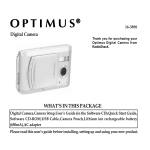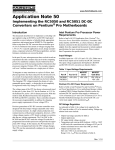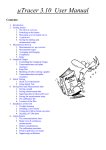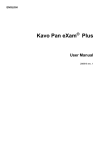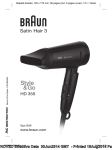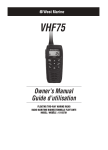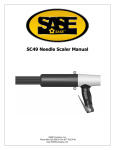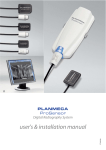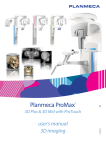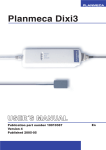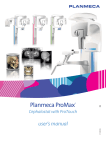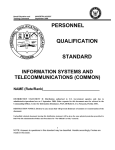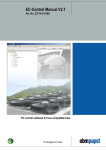Download XIIMUS CL User Manual v1.4
Transcript
XIIMUS CL User Manual. Models 512CT, 1024CT, 2048CT. Version 1.5 XIIMUS MODELS: 512CT, 1024CT & 2048CT USER MANUAL ver 1.5 18 October 2006 TVI Vision Oy reserves the right to change any information in this document without prior notice. TVI Vision Oy will not take any responsibility for any damage caused by possible inaccuracies or faults in the equipment. This document may not be copied without the written consent of the TVI Vision Oy. An unauthorised use or distribution of this document to a third party is prohibited. 18/10/2006 10:25:00 XIIMUS CL User Manual. Models 512CT, 1024CT, 2048CT. Version 1.5 DOCUMENT HISTORY Version Date Author Description 1.0 11 Jun 2003 jjl&nr Initial Release 1.1 19 Aug 2003 jjl&nr Update on ordering codes and model numbers. Update on serial communication protocol: - v1.7 - readout of pixel frequency - Escape-sequence for synchronizing Timings for new models: - multiplexed output - 3 x 512 pixel models 1.2 9 June 2006 jjl&nr Description of CC1 to CC4 signals. Update on specifications. New timing diagrams. Update on serial communications. Several minor corrections. 1.3 9 June 2006 nr&jjl Appendix C: Serial communications Firmware updates: D11 Æ D13 and D12 ÆD14 Read-out of temperature status Time-out at RS-232 port 1.4 6 July 2006 jjl Appendix: Cooling Option. Update on total spectral response graphs. 1.5 18 Oct 2006 jjl Minor changes in wording. © TVI Vision, 18 October 2006 page 2 ( 57 ) XIIMUS CL User Manual. Models 512CT, 1024CT, 2048CT. Version 1.5 DECLARATION OF CONFORMITY AS DEFINED BY THE COUNCIL DIRECTIVE 89 / 336 / EEC EMC (ELECTROMAGNETIC COMPATIBILITY) WE HEREWITH DECLARE THAT THIS PRODUCT COMPLIES WITH THE FOLLOWING PROVISIONS APPLYING TO IT. Emission CISPR 22 (1997) Immunity IEC 61000-6-2 (1999) APPLICABLE PATENTS: FI 97264 US 6,476,870 EP 0 788 709 CA 2,203,835 JP 3626998 © TVI Vision, 18 October 2006 page 3 ( 57 ) XIIMUS CL User Manual. Models 512CT, 1024CT, 2048CT. Version 1.5 TABLE OF CONTENTS 1. INTRODUCTION ............................................................................................................ 5 2. PRECAUTIONS ............................................................................................................. 6 3. CAMERA OVERVIEW ................................................................................................... 8 3.1 3.2 4. COLOUR SEPARATION ................................................................................................... 8 CAMERA OPERATION ..................................................................................................... 8 PROCESSING OF CCD OUTPUT............................................................................... 11 4.1 ANALOGUE VIDEO PATH ............................................................................................... 11 4.2 PIXEL CORRECTION UNIT .............................................................................................. 12 4.2.1 Description......................................................................................................... 12 4.2.2 Data order.......................................................................................................... 12 4.2.3 Correction algorithm .......................................................................................... 12 4.2.4 Implementation of the correction ....................................................................... 14 5. CAMERA INTERFACE ................................................................................................ 16 5.1 5.2 5.3 5.4 5.5 6. POWER INPUT ............................................................................................................. 16 LED INDICATORS ........................................................................................................ 17 DATA CONNECTOR ...................................................................................................... 18 RS-232 PORT ............................................................................................................. 19 PROGRAMMING CONNECTOR ........................................................................................ 19 MECHANICAL STRUCTURE ...................................................................................... 20 6.1 6.2 7. MECHANICAL DIMENSIONS AND MOUNTING OF THE CAMERA ........................................... 20 ATTACHMENT FOR OPTICS ........................................................................................... 20 OPTICAL CONSIDERATIONS .................................................................................... 21 7.1 SPECTRAL RESPONSE ................................................................................................. 21 7.2 SELECTION OF OPTICS ................................................................................................. 22 7.2.1 Modulation transfer function .............................................................................. 22 7.2.2 Resolution and field of view............................................................................... 23 7.2.3 Depth of field and working aperture .................................................................. 24 8. LIGHTING .................................................................................................................... 25 8.1 8.2 SPECTRAL RADIANCE AND COLOUR TEMPERATURE ........................................................ 25 UNIFORMITY OF LIGHTING ............................................................................................ 25 9. TECHNICAL SPECIFICATIONS ................................................................................. 27 10. APPENDIXES .............................................................................................................. 29 10.1 APPENDIX A: CAMERA LINK® OUTPUT BIT PORT ASSIGNMENTS ................................ 30 10.2 APPENDIX B: TIMING DIAGRAMS ........................................................................ 31 10.2.1 B1: Parallel colour channels output modes ....................................................... 31 10.2.2 B2: Multiplexed colour channels output modes................................................. 32 10.3 APPENDIX C: SERIAL COMMUNICATIONS ............................................................ 33 10.4 APPENDIX D: MODEL NUMBERS FOR XIIMUS CAMERAS ..................................... 51 10.5 APPENDIX E: ORDERING CODES FOR XIIMUS CAMERAS ..................................... 52 10.6 APPENDIX F: APPLICATION NOTES ..................................................................... 54 10.6.1 TVI-AN701: Using encoder Inputs for triggering ............................................... 54 10.7 APPENDIX G: COOLING OPTION ......................................................................... 56 © TVI Vision, 18 October 2006 page 4 ( 57 ) XIIMUS CL User Manual. 1. Models 512CT, 1024CT, 2048CT. Version 1.5 INTRODUCTION The XIIMUS is series of a rugged, high performance, fully digital colour line scan camera for demanding industrial applications. It utilises a high accuracy 3-CCD architecture with a choice of either 512, 1024, 2048 or 4096 pixel sensors at speeds up to 40 million pixels per second per colour channel. The TVI Vision XIIMUS cameras are optimised for high sensitivity and precise colour recognition. The applications for the XIIMUS cameras include: • web inspection • inspection of natural materials like food, wood, ore, minerals and lumber • recycling • quality control in printing processes • texture recognition CUSTOMER SUPPORT If you need to contact the manufacturer directly, please send your questions preferably by email to TVI Vision. They will be forwarded to the responsible persons, who will contact you as soon as possible. E-mail: Fax: Phone: [email protected] +358 9 7590 0319 +358 9 759 001 Address: Asentajankatu 3 00880 Helsinki FINLAND © TVI Vision, 18 October 2006 page 5 ( 57 ) XIIMUS CL User Manual. 2. Models 512CT, 1024CT, 2048CT. Version 1.5 PRECAUTIONS Read the manual Please read the manual carefully before using the camera the first time. Do not drop the camera Handle the camera with care at all times, since it is a sensitive optical device. Do not drop the camera and avoid mechanical shocks to the camera. Keep foreign matter outside the camera Do not spill liquids on the camera. The camera is not liquid or waterproof. Do not drop any kind of objects or foreign material into the camera. Metallic objects might cause short circuit and/or damage the optical assembly. Cleaning Keep the shade cap on the camera head when not used to avoid contaminating the prism. The input surface of the prism is not shielded nor protected from the outside of the camera. It is recommended that the camera is serviced by TVI Vision, if the front surface of the prism is very dirty, since the surface area of the prism cannot be fully accessed from the front. If there are small amounts of contaminants or dust on the prism surface, use a clean lint free cotton swab or other non-abrasive medium dipped in acetone or pure alcohol to clean prism surface. Shake excess solvent off before touching the surface of the prism to avoid streaking. TVI Vision is not responsible for any scratches or damage inflicted by the customer to the front surface of the prism. To clean the exterior casing of the camera, use a soft, dry cloth. In case of severe stains use a small amount of pure alcohol. Do not use isopropyl alcohol or acetone or other volatile solvents such as benzene or thinners. Do not open the camera Do not open the camera. In doing so, the warranty of the camera will expire immediately. Only authorised service personnel may open the camera. Ventilation Allow sufficient air circulation around the camera. If this condition is not met the camera might shut down during operation, because it is designed to do so in order to prevent damage to the optical assemblies. Further increase of the temperature may damage the camera. © TVI Vision, 18 October 2006 page 6 ( 57 ) XIIMUS CL User Manual. Models 512CT, 1024CT, 2048CT. Version 1.5 Storage Do not store the camera in a temperature over +55 ºC or 131 F. There is a permanent temperature indicator inside the camera, which is installed to ensure that if the camera is damaged due to overheat, the warranty of the camera may be void. Electromagnetic fields Do not operate the camera in the vicinity of strong electromagnetic fields (above the requirements of CE conformity). This may cause erroneous operation of the camera. Transporting Preferably transport the camera in its original packaging. If the package is discarded, please package with care in thick layer of soft, preferably anti-static material when transporting. Do not use material that allows the camera to drop to the bottom of the package while transporting. Do not transport with an objective attached. Let the camera slowly reach the ambient temperature after transportation before powering it up the first time. © TVI Vision, 18 October 2006 page 7 ( 57 ) XIIMUS CL User Manual. Models 512CT, 1024CT, 2048CT. 3. CAMERA OVERVIEW 3.1 Colour Separation Version 1.5 The incoming light is separated into three, Red, Green and Blue, colour images by an RGB beam splitter (figure 3.1). The spectral distribution of each colour is standardised and well known. By attaching a CCD to each of these colour outputs, it is possible to measure the intensity of each colour image. GREEN BLUE RED INCOMING LIGHT Figure 3.1 3 x CCD R G B RGB color line Figure 3.2. 3.2 The RGB colour separation beam splitter. The CCDs are aligned to each other to get the perfect image of the three measured colour components. All the three CCDs see exactly the same area of the target from same viewing angle, distance and at the same time. Corresponding pixels of all the three sensors are very precisely positioned optically in the same place. This makes the colour analysis simpler and does not require any line matching or synchronising of separate colour lines. The resolution of the camera is the same as for the individual CCD array. Alignment of the CCD linear arrays. Camera Operation The CCDs convert incoming light into electrical charge. The amount of charge generated in each of the individual pixels is directly proportional to the intensity of light they receive. The resulting charge packets are transferred into two high-speed CCD shift registers and transferred to the output charge-to-voltage converters of the CCDs. The generated output video is Correlate Double Sampled (CDS) and amplified by two user accessible gain factors prior to digitisation into 12 bits. © TVI Vision, 18 October 2006 page 8 ( 57 ) XIIMUS CL User Manual. Models 512CT, 1024CT, 2048CT. CDS A D Version 1.5 Data out 12 bits PCU CCD CDS A D 12 bits CDS A D 12 bits Non volatile memory voltage monitoring CCD CDS A D 12 bits CDS A D 12 bits temperature monitoring CTRL Ctrl out CCD Ctrl in CDS A D 12 bits RS 232 2 TIMING GAIN CTRL OSC Vin Figure 3.3. 2 DC DC The block diagram of the camera. The XIIMUS cameras operate in a mono-shot mode. For each rising edge of the NewLine signal the camera responds by sending out the digital data stream of the previous line scan period time. The output frequency is constant. The distance in time between two NewLine edges can be set to any value above the specified minimum. The reciprocal of this time is the line rate (Hz). The XIIMUS cameras have been optimised for high-speed applications. Therefore best performance is achieved at line rates of hundreds of lines per second or above. Line scan rate Line 1 Line 2 Line 3 Line 1 Line 2 NewLine ( CC1 ) Data out Figure 3.4. Line 0 Line 3 The relation of the data output and NewLine signals. © TVI Vision, 18 October 2006 page 9 ( 57 ) XIIMUS CL User Manual. Models 512CT, 1024CT, 2048CT. Version 1.5 The effective integration time can be made shorter than the actual exposure time (time between two consequent NewLine (CC1) pulses, Line scan period) by holding the ExpCtrl (CC2) signal in its active stage until the beginning of the targeted interception period. Within the exposure time, whenever the ExpCtrl input is held low, no charge can be collected into the pixels. This is why the actual integration time is the distance in time of the (last) rising edge of the ExpCtrl input signal and the next rising edge of the NewLine input. Figure 3.5. The line rate and the integration time (data is drawn for muxed output mode). The two most common operation modes of line scan cameras are free-run mode or encoder input driven mode. In the free run mode both the line rate and the integration time can be precisely controlled. But if the line rate is determined by encoder input, the integration time can best be kept constant by using the encoder input pulse for generating the ExpCtrl signal. The NewLine pulse is sent after a constant delay (appendix F). The XIIMUS camera is constantly monitoring all the internal supply voltages and the internal temperature of the camera. Temperature warnings can be monitored via the LEDs of the rear panel or by reading the status via serial communications. Other functions include: • • • • • • colour channel specific programmable exposure control, analogue gain, digital gain and offset retrieval of the firmware versions and serial number non-volatile memory banks for the programmable settings user programmable pixel correction unit test pattern generation for interfacing self-clocking mode for operation at fixed line rate without line request input © TVI Vision, 18 October 2006 page 10 ( 57 ) XIIMUS CL User Manual. Models 512CT, 1024CT, 2048CT. 4. PROCESSING OF CCD OUTPUT 4.1 Analogue video path Version 1.5 TVI XIIMUS cameras utilise a two channel CDD for each colour. A simplified illustration of the analogue video path of one channel is in figure 4.1.The video path itself is completely analogue until digitised with 12-bit resolution in close vicinity of the CCD itself. All adjustments performed on the analogue video signal are digitally controlled. Figure 4.1. Analogue video path The analogue video signal is first Correlate Double Sampled and amplified in the preamp gain stage. After the CDS block it is possible to further amplify the signal with an analogue gain stage. The analogue video path also includes an input clamp circuit that is not drawn in the illustration. The input clamp circuit removes the CCD’s optical black offset to maximise system headroom and the effect of gain change on the black level. The effect of this circuit causes the digital output data to start from zero when the CCD is exposed to dark. If desired, the dark level register can be used to set a positive offset in the output data. If this parameter differs from zero, the dark level of channel in question will have an offset equal to the dark level setting. Changing this setting can be desirable when using the pixel correction unit, since the pixel to pixel variations in dark will be present in the raw data enabling better correction. Lastly the 12-bit data streams from the two output channels are digitally multiplexed into one data stream to represent the CCD output. © TVI Vision, 18 October 2006 page 11 ( 57 ) XIIMUS CL User Manual. 4.2 4.2.1 Models 512CT, 1024CT, 2048CT. Version 1.5 Pixel correction unit Description The TVI XIIMUS series line scan cameras incorporate a user programmable real time pixel correction unit, PCU. The PCU can be set up by downloading appropriate correction data via the serial port to the camera. The PCU can simultaneously perform white balancing, removal of pixel to pixel offsets (PRNU & DSNU), lighting profile correction, removal of lens curvature and/or perform custom operations on the output data of the camera. 4.2.2 Data order The correction data consist of 24 bits of data per colour pixel. Thus, for a full RGB pixel the user has to provide 72 bits of data. The data is sent to the camera via serial communications port starting with the first pixel in the line. Colours are sent in RGB order to the camera. The start of the transmission to the camera is illustrated below, each letter corresponds to one byte (8 bits) of data: 1 RRR GGG BBB 2 RRR GGG BBB 3 R.. Within a single colour pixel the data is ordered into a multiplier and an offset. The multiplier consists of 14 bits and the offset of 10 bits. Thus, the three bytes that make up the correction data for one colour pixel are internally divided on a bitwise level as follows: R (byte 0) Multiplier 13 12 11 10 9 8 7 6 R (byte 1) 5 4 3 2 1 0 R (byte 2) Offset 9 8 7 6 5 4 3 2 1 0 Please refer to the serial communication section of this document for additional information on how to download correction data to the camera. 4.2.3 Correction algorithm The pixel correction unit (PCU) utilises a simple linear algorithm to correct the digital output data of the camera. The formula below is used to correct all data once correction is enabled: yi = (xi - bi) x ai yi = corrected output data xi = camera raw data bi = offset to be subtracted from the raw data ai = multiplier for scaling of data Since the offset bi has a 10-bit range, it is possible to subtract greater values than the camera dark level, which is typically around 40 DU. As an example, the user might want to subtract the background of the image instead of the dark level. © TVI Vision, 18 October 2006 page 12 ( 57 ) XIIMUS CL User Manual. Figure 4.2. Models 512CT, 1024CT, 2048CT. Version 1.5 Correction algorithm. The multiplier ai has a 14-bit range. The multiplier is scaled so that a 14-bit multiplier value of 4096 DU by default equals multiplying by one. So, in order to increase the signal of a pixel it has to be multiplied with a number greater than 4096 DU and accordingly it has to multiplied with a smaller number to attenuate the signal. This means that a single pixel cannot be multiplied with a multiplier greater than 4 or attenuated more than into 1/4096. Please note that multiplying with a number that is larger than one (4096) will result in some more noise in the image, because the original data is scaled up (“stretched”) to cover a larger range. By altering the content of the shifter register, it is possible to reset the multiplier unity level to any power of two between 128 and 16384. Please notice, that setting this register to 16384 will not permit any amplification, but on the other hand will permit fine resolution attenuation. Also, setting this register to low values will permit much amplification, but will make the multiplier effect coarser at values close to the selected unity value. As mentioned above, the correction unit can perform multiple corrections on the image with one set of correction data. White balancing or any user defined colour balance can be achieved by multiplying the colour channels that have a response differing from the desired response with suitable multipliers. © TVI Vision, 18 October 2006 page 13 ( 57 ) XIIMUS CL User Manual. 4.2.4 Models 512CT, 1024CT, 2048CT. Version 1.5 Implementation of the correction Figure 4.3. Block diagram of the correction data path. The correction algorithm is implemented as illustrated above for each colour channel. Firstly, all offsets are subtracted from the raw 12-bit CCD output data. This includes the pixel to pixel offsets in the dark (DSNU) and any custom subtractions. In the diagram this subtraction is marked as SUBi. Also, the colour channel specific offset is subtracted from the raw data. Thus, altogether it is possible to subtract half of the camera dynamic range from the raw data. Secondly, after performing the subtractions, the data is multiplied with a 14-bit pixel specific multiplier. This will result in a maximum of 26 bits of data per pixel, out of which, the topmost 12-bits are routed to the data output of the camera. The output data passes through a left shifter where it is possible to digitally amplify the data by shifting it zero to seven positions to the left. Also, the shifter will shift the data to the correct location depending on the unity multiplier level set in the shifter register. Example: The shifter register is set to 7, which equals 128 as a unity multiplier. The digital gains are set to 7 as well, which equals 128x digital gain. In this case, the result after the multiplication is shifted up 14 positions which means the lowest 12-bits of the resulting 26-bits are shifted to the data output. Example on performing multiple corrections White balancing can be achieved by selecting the multipliers so that the data values on all colour channels are equal in digital response from pixel to pixel. Normally, the channel that is closest to saturation is selected as a reference where the other channels are corrected. Other choices are possible but they limit the dynamic range of the output signal. The image below depicts a typical situation. In the image, the output of the red channel is where the other two channels are corrected. Now, to achieve white balance, the red channel line has to be multiplied with a constant one for every pixel in the line and the green and blue channel pixels with multipliers of little over one varying from pixel to pixel, so that each colour pixel will have a balance of its own. © TVI Vision, 18 October 2006 page 14 ( 57 ) XIIMUS CL User Manual. Models 512CT, 1024CT, 2048CT. Version 1.5 In order to remove unevenness of the lighting profile and lens curvature along the vector at the same time as when performing white balancing, each individual pixel along the vector needs to be scaled to the corresponding red maximum value (L1). Now, in this case, in order for the line profile on all colour channels to equal line L1, the red channel line also has to be scaled. Thus, at the beginning of the red line, the lowest pixel value at level L2 has to be multiplied with a multiplier Rx, so that it equals line L1. Accordingly, at the start of blue channel line, the line L3 has to match line L1 for the camera to be in white balance. As illustrated in fig. 4.4, the blue channel will have the largest multipliers and the centre of the red channel line will have multipliers close to unity. Also, the far ends of each colour channel will have the largest multipliers of the colour channel in question. Figure 4.4. Correction in the direction of the vector. © TVI Vision, 18 October 2006 page 15 ( 57 ) XIIMUS CL User Manual. 5. Models 512CT, 1024CT, 2048CT. Version 1.5 CAMERA INTERFACE All the electrical connections of the XIIMUS colour line scan camera are made via the rear panel. The DC power is input via the 2-wire, shielded power cable (included in the delivery). The cable side connector should be pushed and pulled by holding on to the sleeve at the central part. It must never be turned or pulled by holding on to the rear part of the connector or the cable itself. The two Camera Link® connectors are used for interfacing to commercial Camera Link frame grabber boards or users' own electronics. All signals are available on the two Camera Link connectors. The interface is designed according to Camera Link specification v1.1. Standard RS-232 interface is used for modifying the parameters of the camera. The serial port interface is also available on the first Camera Link connector according to the specifications. The port is set according to the purchase order. The selection can be swapped by software. Additionally, there is a hardware method to move the port to RS-232 connector (instructtions available on request). Six indicator LEDs (on the right hand side) show the status of the camera. Figure 5.1. The rear panel layout for Camera Link® models. 5.1 Power input The connector is labelled as ‘PWR IN’. A power cable is included in all the camera shipments. The bottom most pin of the cable represents the positive supply voltage and the topmost is the respective zero volts. The mating power connector part number is: odu S21L0CT02LPH0-6200. The recommended cable bend relief can be ordered with p/n code: odu 701.022.208.960.050. The XIIMUS cameras operate from a single supply voltage of nominally +24 VDC at typically 500 to 1000 mA depending on the operation mode and the external terminations of the output signals. The maximum power consumption is 26 W. For low frequency line ripples (less than 120 Hz) ± 10 % of ripple is acceptable as long as the voltage level stays between +20 to +36 VDC. © TVI Vision, 18 October 2006 page 16 ( 57 ) XIIMUS CL User Manual. Models 512CT, 1024CT, 2048CT. Supply voltage: Nominal: Range: +24 VDC +20 to +36 VDC Supply current: Typically: Maximum: 500 to 1000 mA 1.1 A (at +24 VDC and at power-up only) Version 1.5 Ripple: ± 10 % (max 120 Hz) - voltage level (=nominal + ripple) must stay between +20 to +36 V 5.2 LED indicators From top downwards the LEDs are as follows: POWER, green ON: power input OK ON: normal operation OFF: ¹ The higher temperature limit has been exceeded and the camera operation has been shut down. After the external temperature has fallen into the specified range, switch the power once OFF and then ON again. RUN, green ² The camera did not start up properly. Check the input power lines and the POWER LED. The power supply must be able to supply enough current quickly at beginning of the power-up. STATUS 1, green ON: correction unit (PCU) is enabled OFF: correction unit (PCU) is disabled STATUS 2, green ON: camera is ready for operation OFF: camera is performing internal boot cycle PWR ERROR, red ON: © TVI Vision, 18 October 2006 at least one of the internal supply voltages has failed page 17 ( 57 ) XIIMUS CL User Manual. Models 512CT, 1024CT, 2048CT. Version 1.5 TEMP ERR, red ON: 5.3 Warning of too high an internal temperature. If the camera cools down, this warning will be removed, but if the temperature rises further the camera will be stopped permanently until the next power-up. Please note that this is only an early warning of high operating temperature and that it is permitted to use the camera even when this warning is continuously on. The status of temperature monitoring can be read via serial communications. Data Connector Two MDR-26 connectors handle the data communication according to the Camera Link specification. The connectors are labelled CL1 and CL2. CL1 is for Base Configuration. Both connectors are needed for Medium and so called Dual Base (non-standard) Configurations. Cables can be secured with either screw locks or latches. All signals are specified by the Camera Link standard, except the four Camera Control inputs: CC1 NewLine - the rising edge defines the change-of-line moment (after a constant delay) - period is the line rate CC2 Exposure Control Red (or all channels) - exposure control signal for the Red channel - the effect for this is defined by the mode that is selected via RS-232 interface or Camera Link serial port - as default this signal is common to all the three CCDs - a low level resets all the pixels - should be constantly high, if full time exposure is needed - a constant '0' results in dark images CC3 Exposure Control Green - exposure control signal for the Green channel when camera is set to individual exposure control mode CC4 Exposure Control Blue - exposure control signal for the Blue channel when camera is set to individual exposure control mode For cabling please refer to the Camera Link specifications. TVI Vision also provides Camera Link cables. Please contact sales ([email protected]). All the input signals are internally terminated by 100 Ω resistors. All the output signals should be terminated respectively (one 100 Ω resistor connected between the positive and negative wire of each signal pair). Appendix A shows the output bit port assignments of all the available Camera Link modes. Appendix B presents the timing details of the interface signals. © TVI Vision, 18 October 2006 page 18 ( 57 ) XIIMUS CL User Manual. 5.4 Models 512CT, 1024CT, 2048CT. Version 1.5 RS-232 port The RS-232 connector is used for changing the settings of the camera and for communicating with the internal microcontroller. Please, refer to the Appendix C for detailed description on wiring and the communication protocol. The same functions are alternatively available via Camera Link. The advantages of this separate port are faster operations due to hardware handshaking and independence of the image grabbing. TVI Vision provides free software with source codes for both options. Please specify the port, when ordering cameras. The connector is a standard 9-pin, plug type connector with the following pin-out as seen from the behind of the camera: Figure 5.2. The pin numbers of the RS-232 plug connector. Table 5.1. Pin-out of the RS-232 connector PIN 1 2 3 4 5 6 7 8 9 5.5 NAME RD TD SG RTS CTS - DIRECTION DESCRIPTION input output Receive Data Transmit data - Signal Ground output input Request To Send Clear To Send Programming connector The 15-pin D-shell connector on the left side of the back plane is reserved for factory use. New firmware updates can also be downloaded using this connector. Ask TVI Vision for detailed procedure, before removing the cover of the connector. © TVI Vision, 18 October 2006 page 19 ( 57 ) XIIMUS CL User Manual. Models 512CT, 1024CT, 2048CT. 6. MECHANICAL STRUCTURE 6.1 Mechanical dimensions and mounting of the camera Version 1.5 The mechanical structure of the camera provides a compact entity to meet the rigid demands of the industrial environment. The camera case is aluminium, which provides an excellent electrical protection against external electromagnetic interference. When selecting the components, corrosion resistance has also been considered. The camera can be mounted from the front panel or from the side panel of the camera. The recommended way to mount the camera is to use the three M5 holes, which are situated around the optics on the front panel. There are three possibilities to mount the camera with the mounting holes at the side of the camera body. First possibility is to fasten the camera with four screws to a special mounting stand. The second option is to use a normal camera tripod, using a standardised tripod attachment 1/4", 20 UNF. The third is to use two M6 threaded holes to attach the camera to any application specific frame or support. Figure 6.1. Dimension drawing of the camera. 6.2 Attachment for optics There is a locking latch in the Nikon bayonet. The optics are attached by turning it (ca. 1/4 rev.) counter clockwise, viewing from the front of the camera, until the latch rises into the upper position. When detaching the optics, push the latch first towards the front panel of the camera and then turn the optics clockwise, again viewing from the front of the camera, until the optics are released from the bayonet. The optics may then be pulled away from the camera. © TVI Vision, 18 October 2006 page 20 ( 57 ) XIIMUS CL User Manual. Models 512CT, 1024CT, 2048CT. 7. OPTICAL CONSIDERATIONS 7.1 Spectral response Version 1.5 Typical relative spectral response (%) The following graph represents the total response of the camera. It is based on spectral transmission measurements of the beam splitter prism and the spectral sensitivity of the CCDs. Channels have been matched to 100% by selecting the gains of the channels. 100 90 80 70 60 50 40 30 20 10 0 300 400 500 600 700 800 900 1000 Wavelength (nm) Figure 7.2. Typical spectral response of complete camera without lens. © TVI Vision, 18 October 2006 page 21 ( 57 ) XIIMUS CL User Manual. 7.2 Models 512CT, 1024CT, 2048CT. Version 1.5 Selection of optics The choice of optics affects the picture quality in terms of resolution, field of view, depth of field and amount of lighting needed, just to name a few factors. The selection of optics can have a dramatic effect on image quality. This is why a basic understanding of optics is required. A few guidelines are presented in this section. It is recommended to contact your supplier or TVI Vision for advice on optics and lightning or to have them verified. 7.2.1 Modulation transfer function Lens systems can vary notably in terms of image quality. Quality can be characterised in terms of Modulation Transfer Function (MTF). MTF gives a measurement of how much contrast is left between two details (usually black and white pairs of lines per mm) after they have been projected. In general it is defined as fidelity of the image in comparison to the object being imaged. Maximum MTF is 1.0, but due to optical imperfections and diffraction, this is impossible to reach. MTF at large apertures (f1.0-2.8) is limited by optical imperfections, which vary a lot from lens to lens and manufacturer. At small apertures (f11 - f32+) lens performance is limited more by diffraction than optical quality, so in this case there are minor differences between lenses and manufacturers. Most lenses produce best results around aperture size f8. Below are two sample graphs of a typical fair quality 50 mm lens at two different apertures. They demonstrate various aspects discussed in the previous and next paragraphs. The graphs represent MTF in percent (y-axis) for three different line frequencies of 10, 20 and 40 lp/mm from top to bottom (lp = line pairs). The solid lines represent sagittal (radial) MTF and the dashed lines tangential (circular) MTF. If the sagittal and tangential line pairs do not coincide, this indicates aberration, such as astigmatism. The x-axis represents the distance of from the centre of the image to the edge in millimetres. Figure 7.3 : MTF for a 50 mm objective at two apertures and different spatial line frequencies (graphs kindly provided by © Photodo AB, Sweden) © TVI Vision, 18 October 2006 page 22 ( 57 ) XIIMUS CL User Manual. Models 512CT, 1024CT, 2048CT. Version 1.5 The effect of MTF is application dependent. If very small details are to be examined or fine colour separation to be performed by the image processing system, MTF might play an important role in the application. If the objective has field curvature, it will show up in the MTF plot as MTF dropping away from the centre of the image. Observing the plots, it is evident that this is true to wider apertures that have a small depth of field. This does not necessarily mean that sharpness is worse at the edges. It can just as well be that optimal focus for objects close to the edge is closer or further away from the lens. Normal camera lenses are usually used to photograph threedimensional objects and do not exhibit a perfectly flat focal field. Enlarging or repro optics have a planar focal field and are used to reproduce flat objects. 7.2.2 Resolution and field of view Resolution is primarily affected by sensor dimensions and the quality of optics. It is the ability of an optical system to produce finer details at a tolerable contrast. Normally, according to the Nyquist sampling theorem, it is required that a detail spans at least two pixels to be able to be identified with a reasonable accuracy by an image processing software. Because of the CCD, the fastest transition from black to white can occur within one pixel. When using large apertures, large field of view and the 2K sensor and depending on the quality of the objective used, image quality can be reduced at the edges due to optical limitations. All TVI XIIMUS cameras have been designed and made to be used with standard commercial objectives at mid-range apertures. The focal length of optics required for imaging can be calculated from the following formula: d x L F = ------------ , where FOV F = focal length of the lens (mm) d = distance to object (mm) L = length of the CCD 7.17 mm for 512 pixels (14 µm) 10.24 mm for 1024 pixels (10 µm) 14.34 mm for 1024 pixels (14 µm) 20.48 mm for 2048 pixels (10 µm) FOV = field of view; object size (mm) Example 1 : The distance to the object to be imaged is 900 mm, the width of area to be imaged is 500 mm. When using 1024 pixel 10 µm sensor the focal length of the objective from the equation will be ~18.4, so a 20 mm objective would be ok, if the camera is moved backward to a distance of 977 mm. Example 2 : The size of an object within the image needs to be calculated in pixels. This can be accomplished by rearranging the equation to yield L = FOV x F / d. Thus a 10 mm object with a 50 mm objective at a distance of 900 mm will be projected as 0.56 mm. which equals ~56 pixels in the image (each pixel on the CCD is 0.01 mm by 0.01 mm). © TVI Vision, 18 October 2006 page 23 ( 57 ) XIIMUS CL User Manual. 7.2.3 Models 512CT, 1024CT, 2048CT. Version 1.5 Depth of field and working aperture Optimum sharpness of the image is achieved only when the object is in the focus plane. Behind and in front of this plane the sharpness is worse. Depth of field is defined by how unsharp a point is allowed to be. Depth of field is thus the distance from the plane of focus where the unsharpness stays tolerable. So the depth of field depends on the smallest application dependent feature size to be recognised. Depth of field considerably increases with smaller aperture sizes. Depth of field is also affected by the focal length used. A longer focal length with a given aperture will result in a shorter depth of field. Therefore, as a guideline, if the focal length is increased the aperture has to be stopped down by the same factor to retain the desired depth of field. A lens improves optically when stopped down. At large apertures most of the area of the lens is used, resulting in a slight blur caused by unavoidable imperfections in the lenses. When stopping down, only the central area of the lens is used. The optical picture is more correct and resolution improves. Considering this fact the lens to be used should have a large maximum aperture and should be operated at a mid-range aperture. In reality, stopping down does not improve optical quality endlessly, since diffraction starts to affect image quality at small apertures. According to the law of diffraction a sharp edge turns light slightly off. The aperture forms such a sharp edge and light closest to the edges causes fuzziness in the image. When using wider apertures the percentage of light passing along the edges decreases in relation to light passing through the centre. So, at small apertures the ratio of light passing close to the edges increases and thus small apertures result in a lot of diffraction. Sharpness is therefore limited not just by imperfections in the lens but also by diffraction. Thus, the use of mid-range apertures (f5.6 - 11) results in optimum picture quality. Normally a lens is at its sharpest at aperture 8. TVI XIIMUS cameras are very sensitive to light and have a wide range of user programmable gain factors, so it is possible to use mid-range apertures without significantly increasing lighting costs. © TVI Vision, 18 October 2006 page 24 ( 57 ) XIIMUS CL User Manual. 8. Models 512CT, 1024CT, 2048CT. Version 1.5 LIGHTING Lighting affects the quality of an imaging situation much more than the selection of proper optics. Proper lighting can increase accuracy, system reliability and response time. Furthermore, failure to implement correct object illumination will in most cases lead to loss of time and financial resources. A good image for processing purposes is an image that has the greatest texture contrast in the areas of interest against the background. To be able to reliably process the image these conditions must prevail with certain accuracy over time. 8.1 Spectral radiance and colour temperature The spectral radiance of the lighting used depends on the application, since certain wavelengths of light might produce either additional or the desired information in the application. Generally speaking the spectral distribution of the light sources should be as even as possible in the visible light spectrum from 350 to 700 nm, where the TVI cameras are intended to be operated. Due to the technology used in the camera and the CCDs inherent increased sensitivity to the red end of the spectrum, the lighting should have a considerable blue content in it. The colour temperature of a light source is a pretty accurate measure of the balance of spectral radiance. Reasonable results can be obtained when lighting colour temperature is close to or over 4000K. High quality colour images require a colour temperature of around 6500K or more. Lighting that generates a lot of IR or UV might affect the working of the CCD sensors and should be filtered out or the source of lighting must be chosen so that the content of undesired wavelengths is minimised. 8.2 Uniformity of lighting Uniformity of lighting means that there are negligible variations in light intensity over the used spectrum. Also changes in ambient lighting should not affect the imaging situation. Such a light source is called a lambertian source or uniform diffused light. This light can be collimated to further improve stability and intensity. A lambertian source will do for an imaging situation where shadows and reflections should be minimised. There are many other schemes of lighting which, of course, depend on the application. So it is up to the user to experiment with different lighting schemes to find out what scheme contrasts the desired image feature best. The way the light is driven also has major impact on the evenness of lighting. Normally either high frequency ballasts (order of tens of kHz) are used to drive certain types of lighting or DC lighting is used. Some systems also use three different lamps each driven in a different phase with a square wave instead of a sinusoidal one. In any case if DC lighting is not used, the frequency driving the lights should be considerably higher than the line frequency used in the application. © TVI Vision, 18 October 2006 page 25 ( 57 ) XIIMUS CL User Manual. Models 512CT, 1024CT, 2048CT. Version 1.5 The ageing of the light source should always be considered, since there might be changes in intensity and colour temperature. If there is fine colour based qualification to be done, this aspect should be carefully considered. The temperature dependency of the chosen light source should be verified. For example, fluorescent tubes have a relatively high relation between the operating temperature and both the intensity and the proportion of colour output, while all TVI XIIMUS cameras have almost no changes in their performance. © TVI Vision, 18 October 2006 page 26 ( 57 ) XIIMUS CL User Manual. 9. Models 512CT, 1024CT, 2048CT. Version 1.5 TECHNICAL SPECIFICATIONS Subject to change without prior notice. Table 9.1. Latest update: 2 June 2006. The technical specifications of the TVI XIIMUS series of cameras with 10 µm sensors. Parameter Number of pixels Pixel size Data rate per CCD Line scan period Symbol Min N N Typical Max Unit 1024 2048 10 x 10 texp 28.2 - 40 - µm MHz µs texp 53.8 - - µs 36 bit Vdc (40 MHz model in parallel output mode) Line scan period (40 MHz model in parallel output mode) Gain control A/D conversions Supply voltage Power consumption Weight Operating temperature data rate ≤ 25 MHz per CCD Operating temperature data rate > 25 MHz per CCD Operating temperature data rate > 25 MHz per CCD with integrated cooling option Storage temperature G 100 x Vsupp 12 24 20 12 - 17 1.3 26 W kg ripple: ±10%; voltage + ripple must stay within 20 to 36 V +35 °C without lens 41 to 95 F Top +5 +20 °C 41 to 68 F Top +5 +50 °C 41 to 122 F Tst -10 +55 14 to 131 F - 85 °C % Humidity, storage 5 - 95 % - ±2 4095 © TVI Vision, 18 October 2006 1024 pixels, max. line rate: ≈35.5 kHz 2048 pixels, max. line rate: ≈18.6 kHz response time: 500 ms, max +5 5 Saturation level 100% fill factor m Top Humidity, operating Photo response nonuniformity, p-to-p Notes PRNU ± 10 % 4095 DU relative, non condensing relative, non condensing digital units page 27 ( 57 ) XIIMUS CL User Manual. Models 512CT, 1024CT, 2048CT. Version 1.5 Table 9.2. Latest update: 2 June 2006. The technical specifications of the TVI XIIMUS series of cameras with 14 µm sensors. Parameter Number of pixels Pixel size Data rate per CCD Line scan period Symbol Min N Typical Max Unit 512 1024 14 x 14 µm MHz µs texp 15.4 - 40 - texp 28.2 - - µs G 12 x 100 x Vsupp 20 12 24 36 bit Vdc (40 MHz model in parallel output mode) Line scan period (40 MHz model in parallel output mode) Gain control A/D conversions Supply voltage Power consumption Weight Operating temperature data rate ≤ 25 MHz per CCD Operating temperature data rate > 25 MHz per CCD Operating temperature data rate > 25 MHz per CCD with integrated cooling option Storage temperature 12 - 17 1.3 26 W kg ripple: ±10%; voltage + ripple must stay within 20 to 36 V +5 +35 °C Top +5 +20 °C 41 to 68 F Top +5 +50 °C 41 to 122 F Tst -10 +55 14 to 131 F 5 - 85 Humidity, storage 5 - 95 % - ±2 4095 © TVI Vision, 18 October 2006 512 pixels, max. line rate: ≈64.9 kHz 1024 pixels, max. line rate: ≈35.5 kHz response time: 500 ms, max without lens 41 to 95 F Humidity, operation Saturation level 100% fill factor m Top °C % Photo response nonuniformity, p-to-p Notes PRNU ± 10 % 4095 DU relative, non condensing relative, non condensing digital units page 28 ( 57 ) XIIMUS CL User Manual. Models 512CT, 1024CT, 2048CT. 10. APPENDIXES A: Camera Link® output bit port assignments B: Timing diagrams B1: B2: Version 1.5 Parallel colour channels output modes Multiplexed colour channels output modes C: Serial communications D: Model numbers E: Ordering codes F: Application notes G: Cooling Option © TVI Vision, 18 October 2006 page 29 ( 57 ) XIIMUS CL User Manual. Models 512CT, 1024CT, 2048CT. APPENDIX A: Camera Link® output bit port assignments 10.1 Multiplexed Base Configuration A B C D E Version 1.5 Parallel Dual Base Base 8 bit 10 bit 12 bit 24 bit 0 1 2 3 4 5 6 7 0 1 2 3 4 5 6 7 0 4 5 6 7 8 9 10 11 - 2 3 4 5 6 7 8 9 10 11 - 0 1 2 3 4 5 6 7 8 9 10 11 - 1 2 3 4 5 6 7 0 1 2 3 4 5 6 7 0 - - - Medium 30 bit 36 bit 30 bit 36 bit 4 5 6 7 8 9 10 11 4 5 6 7 8 9 10 11 4 24 bit + LSBs 4 5 6 7 8 9 10 11 4 5 6 7 8 9 10 11 4 2 3 4 5 6 7 8 9 10 11 10 11 2 0 1 2 3 4 5 6 7 8 9 10 11 8 9 10 11 0 2 3 4 5 6 7 8 9 10 11 10 11 2 0 1 2 3 4 5 6 7 8 9 10 11 8 9 10 11 0 5 6 7 8 9 10 11 - 5 6 7 8 9 10 11 2 3 2 3 2 3 X X - 3 4 5 6 7 8 9 2 3 4 5 6 7 8 9 10 1 2 3 4 5 6 7 0 1 2 3 4 5 6 7 8 3 4 5 6 7 8 9 10 11 6 7 8 9 2 1 2 3 4 5 6 7 8 9 10 11 4 5 6 7 0 1 11 9 3 1 2 10 4 2 3 11 5 3 4 2 6 4 6 4 5 3 7 5 7 5 6 X 8 6 8 6 7 X 9 7 9 7 0 2 2 0 10 8 1 3 3 1 11 9 2 2 4 2 10 3 3 5 3 11 4 5 6 7 Note: The grey boxes show bits, which are not intended to be used, but which are present due to the hardware wiring of the camera (copies of output pins). F 'X' is zero as default, but can be taken into customised use by upgrading the camera. © TVI Vision, 18 October 2006 page 30 ( 57 ) XIIMUS CL User Manual. Models 512CT, 1024CT, 2048CT. 10.2 APPENDIX B: 10.2.1 B1: Parallel colour channels output modes Version: Date: 2.02 9 June 2006 Version 1.5 Timing diagrams Firmware L1: R18 for 20 MHz models R17 for 25 MHz models R16 for 33 MHz models R15 for 40 MHz models Firmware L2: D14 FVAL is constantly HIGH. DVAL is identical to LVAL. TVI XIIMUS 512CT, 1024CT and 2048CT Parallel Output Modes Symbol T1 T2 T3 Parameter NewLine low (CC1) Line Scan Period 3 x 512 pixels Min. 80 Max. - Unit ns 20 MHz 25 MHz 33.3 MHz 40 MHz 30.1 24.2 18.3 15.4 - µs 3 x 1024 pixels 20 MHz 25 MHz 33.3 MHz 40 MHz 55.7 44.7 33.7 28.2 - 3 x 2048 pixels 20 MHz 25 MHz 33.3 MHz 40 MHz 20 MHz 25 MHz 33.3 MHz 40 MHz 106.9 85.6 64.4 53.8 0.39 0.45 0.52 0.54 2 2 0.44 0.49 0.55 0.565 - Delay to Change of Line 1 T4 T5 Effective Integration Time Delay to Exposure Control active (CC2 … CC4) µs µs µs 1 Please note the jitter of one STROBE clock period. There is no jitter, if the Line Scan Period equals an even number of pixel clocks. © TVI Vision, 18 October 2006 page 31 ( 57 ) XIIMUS CL User Manual. Models 512CT, 1024CT, 2048CT. Version 1.5 10.2.2 B2: Multiplexed colour channels output modes Version: Date: 2.02 9 June 2006 Firmware L1: R19 for 8.3 MHz models K01 for 16.7 MHz models Firmware L2: D13 Notes: swap letters R and B of data values for BGR output sequence FVAL is constantly HIGH. DVAL is identical to LVAL. TVI XIIMUS 512CT, 1024CT and 2048CT Multiplexed Output Modes Symbol T1 T2 Parameter NewLine low (CC1) Line Scan Period 3 x 512 pixels Min. 80 Max. - Unit ns 8.3 MHz 16.7 MHz 71.6 36.9 - µs 3 x 1024 pixels 8.3 MHz 16.7 MHz 133.0 67.6 - 3 x 2048 pixels 8.3 MHz 16.7 MHz 256.0 129.0 - 8.3 MHz 16.7 MHz 0.7 0.8 0.9 0.9 µs 2 2 - µs µs T3 Delay to Change of Line 1 T4 T5 Effective Integration Time Delay to Exposure Control active (CC2 … CC4) 1 Please note the jitter of five STROBE clock periods. There is no jitter, if the Line Scan Period equals a multiple of six pixel clocks. © TVI Vision, 18 October 2006 page 32 ( 57 ) XIIMUS CL User Manual. 10.3 APPENDIX C: Version: Date: MCU software version: 1. Models 512CT, 1024CT, 2048CT. Version 1.5 Serial communications 2.0 2 June 2006 J04 Description The TVI XIIMUS series line scan cameras have user programmable features, which are available by using the RS-232 or the Camera Link® serial communications port and a simple protocol. If your camera does not support all of these features or if you are not sure which functions are included, please contact TVI Vision for details and upgrades ([email protected]). This document describes the communication and all the available functions as low-level ® details for developing users' own application software. Alternatively, a Windows software with source codes and documentation is available from TVI Vision. Separate versions of the software are available for use with either the Camera Link® or RS-232 serial communications interface. Use of the Camera Link® version of the software requires a frame grabber fully compatible with Camera Link® specification version 1.1. (an example) © TVI Vision, 18 October 2006 page 33 ( 57 ) XIIMUS CL User Manual. 2. Models 512CT, 1024CT, 2048CT. Version 1.5 Cabling The RS-232 connector can be found on the rear panel of the camera. Use standard socket type 9-pin D-connectors (e.g. AMP 344643-1) at both ends. These cables are available from TVI Vision by the product name PRICABLE-13. Camera side D9 connector TD (Transmit data, output) RD (Receive Data, input) RTS (Request To Send, output) CTS (Clear To Send, input) SG (signal ground) Pin Pin 3 2 2 3 7 8 8 5 7 5 PC side D9 connector RD (Receive Data, input) TD (Transmit data, output) CTS (Clear To Send, input) RTS (Request To Send, output) SG (signal ground) For Camera Link® serial communication, the port is available on the first connector CL1. A standard Camera Link® cable is used. 3. Communication Programming of the camera is based on 64 8-bit registers that can be loaded with new values any time during operation. New values are sent as sets of two bytes, where the first byte is the address of the register (command) and the second byte is the data (new value). The camera responds to each valid setting by sending the same values back (8-bit address and 8-bit data). Invalid commands are acknowledged with error codes after which the camera immediately returns to command polling state. The camera is ready to accept the next command once it has replied to the command and data byte pair issued. Note: Some PC's send data to the RS-232 port during boot up. If the bytes are not valid commands, the camera will reply with error codes and no changes are made to the camera settings. If these extra bytes are valid for the camera, their effect can be removed by reloading the parameters from the memory bank 0. ADDRESS 192 to 203 204 205 to 207 208 209 210 211 to 216 217 to 222 223 to 228 229 230 231-239 240-255 FUNCTION Programmable Gains Exposure Control Mode Digital Gains OutMode Register Shifter Register Test Modes Preamp Gains Dark Levels Offset registers Reserved for future use Bit Rate Register Reserved for future use Reserved for customer use © TVI Vision, 18 October 2006 DATA 0 0 0 0 2 0 0 0 0 0 1 0 0 page 34 ( 57 ) XIIMUS CL User Manual. Models 512CT, 1024CT, 2048CT. Version 1.5 The values of these registers form a so-called memory bank, which can be saved into one of the internal nonvolatile memory banks for future reloading. All the registers are automatically set to the values of the memory bank 0 (see 3.4 for details) on power-up. The contents of this default memory bank can be altered with the memory commands. Two commands are available for selecting a memory bank: ADDRESS 190 191 FUNCTION Load from memory Save to memory MEMORY BANK ADDRESSES 0 to 63 0 to 59 It is also possible to read the current settings that are in use but not saved to a memory bank. ADDRESS 189 FUNCTION Read Buffer DATA 189 There are five exceptions to the above commands. The Escape-, Retrieve information-, Read Correction Coefficients-, Load from memory- and Read Buffer- commands do not return the address and data of the command itself. Instead, the camera sends out the contents of the selected memory bank or the current settings in use (see corresponding sections for details). In addition to the commands that modify registers, there are several commands that retrieve information from the camera or they are used to set up the Pixel Correction Unit (PCU, see appropriate sections of this document for more details). ADDRESS 180 181 182 to 186 187 188 FUNCTION Reserved for future use PCU Setup Commands Reserved for future use Escape Retrieve Information DATA 0 181, 182, 183 or 184 0 186, 187, 188, 189, 192, 193 or 194 Initial communication parameters: Set the RS-232 port to 19200 bits per second, 8 data bits, no parity and one stop bit (19200,8,N,1). RTS/CTS handshaking is used. Set the Camera Link® port to 9600 bits per second, 8 data bits, no parity and one stop bit (9600,8,N,1). The camera is shipped with the above settings with the RS-232 port initialised as the default serial port. The communication baud rate can independently be set on both serial ports to 9600, 19200 or 38400 bits per second. The port can also be transferred to the Camera Link® serial port. © TVI Vision, 18 October 2006 page 35 ( 57 ) XIIMUS CL User Manual. Models 512CT, 1024CT, 2048CT. Version 1.5 Error Codes: Error START and/or STOP bit error Illegal command Illegal data Illegal data for the LOAD command Illegal data for the SAVE command Data mismatch PCU load timeout 3.1. decimal 101 followed by 49 101 followed by 50 101 followed by 51 101 followed by 52 101 followed by 53 101 followed by 54 101 followed by 55 hexadecimal 65 followed by 31 65 followed by 32 65 followed by 33 65 followed by 34 65 followed by 35 65 followed by 36 65 followed by 37 binary 0110 0101 followed by 0011 0001 0110 0101 followed by 0011 0010 0110 0101 followed by 0011 0011 0110 0101 followed by 0011 0100 0110 0101 followed by 0011 0101 0110 0101 followed by 0011 0110 0110 0101 followed by 0011 0111 ASCII e1 e2 e3 e4 e5 e6 e7 PCU setup commands (address 181) The camera incorporates a real time Pixel Correction Unit. This command performs reads or writes of correction coefficients between PC and camera using the serial port. Loading and saving of correction data to or from the nonvolatile memory of the camera is also supported. The written set of coefficients will be used for calculations performed by the Pixel Correction Unit, if the correction unit is enabled. Function PCU Setup Commands decimal 181 hexadecimal B5 binary 1011 0101 The data byte for this command can take following values: 181 = download correction data to camera for use (not saved to nonvolatile memory) 182 = download and save correction data to camera nonvolatile memory (data is not in use) 183 = load correction data from nonvolatile memory to camera for use 184 = upload correction data from nonvolatile memory to PC via RS-232 RS-232 port: When using the RS-232 port for the first two downloading operations, the issued command is followed by 9 bytes of data per pixel starting with the first pixel in the line. This equals 24 bits or three bytes per colour. The topmost 14 bits of each colour makes up the multiplier and the bottom most 10 bits accordingly define the offset to be subtracted before multiplication. The ordering of the bytes is shown below: RRR GGG BBB © TVI Vision, 18 October 2006 page 36 ( 57 ) XIIMUS CL User Manual. Models 512CT, 1024CT, 2048CT. Version 1.5 Once all bytes are written to the camera, the camera will reply with the same command and data byte pair that was initially sent to the camera when writing started. While writing is in progress no other commands can be sent to the camera because they will be interpreted as correction coefficients. The fourth operation will echo out all correction data via the RS-port back to the PC. Output data ordering is the same as for the first two commands. Camera Link® serial communications port: The first two downloading operations will first reply to the issued command. Next the camera will poll for the first data byte to be received by the camera. Each byte sent to the camera will be acknowledged as received by the camera by echoing out the same byte. The next byte of data should not be sent to the camera before there is a reply to the previous byte. See above under RS-232 port for data ordering and the amount of bytes to be transmitted. With Camera Link® serial communications the fourth operation will output the first byte of data to the port and wait for it to be acknowledged by sending the same byte back. After acknowledging the first byte, the next byte will be available on the port until all bytes are read out. See above under RS-232 port for data ordering and the amount of bytes to be received. The third operation will retrieve previously saved correction data from the nonvolatile memory to the camera for use. The loaded set of coefficients will be the one used for calculations performed by the Pixel Correction Unit, if correction is enabled. This operation behaves the same with both communications ports. Note: The load operation will be automatically performed when the camera is powered up. There will be no acknowledgement message sent via the RS-232 port in this case. Status LED 2 will light up when the correction data is loaded and until then the camera will not accept any commands. 3.2. Escape (address 187) The Escape code is the only command that does not adhere to the 2-byte sequence. It can be used in situations, where the 2-byte sequence is for some reason lost. If the camera detects this value as the address, it will respond with the respective feedback and returns to the state, where it assumes that the next byte will be an address. Note 1: This value is accepted as data. This is why the Escape command should be sent twice to assure that it will be detected as a command also. Note 2: This command itself does not change any register values - it is only meant for initialising the 2-byte sequence. All the registers should be reprogrammed after this to assure use of the intended values. Function Escape decimal 187 hexadecimal BB binary 1011 1011 This command will reply with 120 decimal or 78 hexadecimal © TVI Vision, 18 October 2006 page 37 ( 57 ) XIIMUS CL User Manual. 3.3. Models 512CT, 1024CT, 2048CT. Version 1.5 Retrieve information (address 188) This command will retrieve various information from the camera. Function Retrieve Information decimal 188 hexadecimal BC binary 1011 1100 The data byte for this command can take the following values: 186 = Read Pixel Clock Frequency 187 = Read Serial Number 188 = Read Hardware Settings 189 = Read Temperature Bits 192 = Logic #1 Firmware version 193 = Logic #2 Firmware version 194 = MCU Software Version 3.3.1. Read Pixel Clock Frequency Once issued, this command will reply with the command byte and a byte that will indicate the pixel clock frequency of the camera. If the camera has multiplexed output, the reply byte has to be divided with three to obtain the pixel frequency per colour channel. 3.3.2. Read Serial Number RS-232 port: When this command is issued, the ten byte serial number of the camera in question is output on the RS-232 port in ASCII text format. The transmission starts with the first character of the serial number. If the serial number is shorter than 10 characters, the extra characters will be spaces (ASCII 32). Example: To obtain the serial number of the camera, send the 2-byte set 188 and 187. The replies with the following ten bytes: 65 50 52 53 48 50 32 32 32 32. The camera serial number is A24502. Camera Link® serial communications port: When this command is issued, the camera will reply with the first byte of the 10-byte serial number string. After the first byte is acknowledged by sending the same byte back to the camera, the camera will output the next byte on the port until a total of ten bytes have been read out in this manner. © TVI Vision, 18 October 2006 page 38 ( 57 ) XIIMUS CL User Manual. 3.3.3. Models 512CT, 1024CT, 2048CT. Version 1.5 Read Hardware Settings This command will reply with two bytes. The first byte of the reply consists of eight bits, which are labelled as follows (MSB first): X X M CL T1 T0 V1 V0 Bit M defines if the camera has parallel or multiplexed output: 0 = Parallel output 1 = Multiplexed output Bit CL indicates whether the camera is with LVDS or Camera Link output 0 = LVDS 1 = Camera Link Bits T1 and T0 are interpreted as pairs and are used to distinguish various custom versions of the camera from base models T1 0 0 1 1 T0 0 1 0 1 Interpretation TVI basic model Custom 0 Custom 1 Custom 2 Bits V1 and V0 are interpreted as pairs and are used to indicate the pixel count of the camera V1 0 0 1 1 V0 0 1 0 1 Interpretation 1024 pixels 2048 pixels 4096 pixels 512 pixels Please contact TVI, if this setting is not correct, as it will affect correct operation of the camera. The second data byte is reserved for future use. 3.3.4. Read Temperature Bits This command will reply with the command byte and a second byte that will indicate the internal temperature level as follows: X X X X X X T1 T0 When both bits T0 and T1 are zeroes, the camera temperature level is ok. When T0 is goes high, a temperature warning is issued, but the camera works normally. A red LED labelled ‘Temp error’ will also light up in the camera backplane to indicate the condition. When the second bit T1 goes high as well, camera image aquisition will be halted and the camera must be rebooted once it has cooled. Serial ports will continue to function normally. The bits marked X are zeroes by default. © TVI Vision, 18 October 2006 page 39 ( 57 ) XIIMUS CL User Manual. 3.3.5. Models 512CT, 1024CT, 2048CT. Version 1.5 Read software and firmware versions The camera will reply to one of these commands with the function address followed by a single byte that indicates the name of the current version of the software or firmware in use according to the following table: LOGIC#1 0-19 R 20-39 K 40-63 W LOGIC#2 0-49 50-99 100-149 150-199 200-255 MCU D A S X M 0-49 50-99 100-149 150-199 200-255 C J Y P L Example: To obtain the MCU software version currently in use, send the 2-byte set 188 (decimal) and 194. The camera returns 188 and 108, which means that Y08 is currently in use. 3.4. Read buffer (address 189) The Read Buffer- command will output the current configuration settings in use in the camera on the serial port. This command is not associated with any of the memory banks. Function Read Buffer decimal 189 hexadecimal BD binary 1011 1101 The data byte for this command is 189. Once this command is issued, the camera outputs 64 command and data byte pairs. See below in Memory functions for more details. 3.5. Memory functions (addresses 190 and 191) The internal nonvolatile memory of the camera is divided into 64 so-called memory banks. Each bank can save the status of all the sixty-four (addresses 192 to 255) registers. Each register is made of 8 bits. Values can only be loaded from the memory as complete sets of 64 registers (memory banks). TVI XIIMUS cameras have a volatile memory buffer, which is updated after each new configuration setting to the camera (command and data pair). A copy of this buffer can be saved to any of the user accessible memory banks and any of the memory banks can be loaded into the buffer (overwrites the old values). Memory bank 0 is automatically loaded, when the camera is powered up. The values are not sent out on power-up. LOAD Bank 0 to read-out the power-up values. To read out the values that are currently in use (but not saved), the Read Buffer-command can be used. Banks 60 to 63 cannot be written to, since they contain factory preset values. Function Load from Memory Save to Memory © TVI Vision, 18 October 2006 decimal 190 hexadecimal BE binary 1011 1110 191 BF 10111111 page 40 ( 57 ) XIIMUS CL User Manual. Models 512CT, 1024CT, 2048CT. Version 1.5 The data byte can be any value as specified in the table below: Memory Bank 0 1 to 59 60 61 62 63 SAVE LOAD yes yes no no no no yes yes yes yes yes yes Notes Power-up values General purpose reserved for factory preset values Minimum usable gain settings High-gain version of bank 63 Copy of the initial values of Bank 0 RS-232 port: LOAD commands are acknowledged by sending out the contents of the selected memory bank. Each of the 64 values is preceded by the address of the respective register. Thus, the camera response starts with (decimal): 192, MSB_gain_value_for_odd_pixels_of_red_channel, 193, MSB_gain_value_for_even_pixels_of_red_channel, 194 and so on until the total of 128 bytes has been sent out. Example: In order to save the settings of the camera to be the power up values send the save command, 191, and then the data, which is 0. For reloading the initial default settings from the Bank 63, send 190 followed by 63 (decimal). Camera Link® serial communications port: Once the LOAD command is issued, the transmission starts with the first byte of the memory bank in question. This byte must be acknowledged by sending it back before the next byte is output on the port. Communication ends when all 64 command and data byte pairs have been output and acknowledged on the serial port. NOTE: Data storage is guaranteed only up to 100 000 SAVE commands. All the memory banks have been preset to use the initial communications port. If the port has been changed after delivery, loading of any of these banks will reset the port back to the initial setting, unless the bank has been overwritten with the new values (not possible to banks 60 to 63). 3.6. Programmable gains (addresses 192 to 203) Each CCD has two output channels and each channel has individual gain controls. The gain is controlled with 10-bit resolution, which corresponds to a range of +2dB to +36dB. The gain is close to linear in decibels with gain values of 91 to 511 and linear in dB with higher values. Gains should be set by first sending the most significant byte of the channel and then sending the least significant byte to the channel in question. Gains will not be updated if only the MSB or the LSB byte of the gain of the channel in question is sent. All the gain settings are relative and specific only to each camera and each register. The absolute values of these registers are not significant - the setting of the gains should be based on the feedback from the actual images. The range of the gain is 10 bits, the topmost 8 bits being the MSB and bottom two bits the LSB byte of the gain. © TVI Vision, 18 October 2006 page 41 ( 57 ) XIIMUS CL User Manual. Models 512CT, 1024CT, 2048CT. Version 1.5 Odd channel represents pixels 1,3,5,...,1023 (up to 2047 with 2048-pixel cameras). Even channel represents pixels 2,4,6,...,1024 (up to 2048 with 2048-pixel cameras). Note: The first output pixel is odd. Most software programs index the first pixel as zero (even). Addresses for the most significant byte of the gain controls: Channel RED GREEN BLUE odd / even odd even odd even odd even decimal hexadecimal binary 192 193 196 197 200 201 C0 C1 C4 C5 C8 C9 1100 0000 1100 0001 1100 0100 1100 0101 1100 1000 1100 1001 Addresses for the least significant byte of the gain controls: Channel RED GREEN BLUE Example 1: odd / even odd even odd even odd even decimal hexadecimal binary 194 195 198 199 202 203 C2 C3 C6 C7 CA CB 1100 0010 1100 0011 1100 0110 1100 0111 1100 1010 1100 1011 How to set the blue channel to maximum gain? Set the selected COM port of the PC to 19200,8,N,2. Set the analog gain of odd pixels of the blue channel to maximum value in the advanced user mode by first sending the respective MSB address, which is 200. After that, send the new setting value 255. Next send the respective LSB address, which is 202 followed by 3 as data. This amounts to 1023 sent to the blue odd channel as the new gain setting. The even pixels of the blue channel are set to maximum by sending the following four decimal numbers: 201, 255, 203 and 3. © TVI Vision, 18 October 2006 page 42 ( 57 ) XIIMUS CL User Manual. 3.7. Models 512CT, 1024CT, 2048CT. Version 1.5 Exposure control mode (address 204) The Exposure Control function can be applied individually to each CCD. As default, one common input signal (ExpCtrl_R) drives all the three CCDs. Alternatively each CCD can have its dedicated input signal for the Exposure Control. Address for modifying the Exposure Control function: Function Exposure Control Mode decimal 204 hexadecimal CC binary 1100 1100 This function is used like the setting of the gains (see above). The data byte consists of eight bits, which are labelled as follows (MSB first): S R1 R0 G1 G0 B1 B0 X Bit S selects the source for the Exposure Control functions: 0 = common ExpCtrl signal (default) 1 = individual ExpCtrl signals The next 6 bits are used as pairs for each colour channel (see table below). As default, these are all zeros, and there is no need to change them. They can, though, be used for testing or debugging the system. In the normal state, Exposure Controls are driven directly from the input pins of the camera (as set by the bit S). The Exposure Control can be set to be always inactive (respective channel is never reset by the Exposure Control) or to be always active (pixels are reset all the time by the Exposure Control - this results to a dark output value for the selected channel). The third choice is a test mode, where the pixels are reset until the end of the LineValid signal. This is a constant time. Thus the amount of exposure will depend on the line rate only (see Timing Diagrams for details). R1 0 0 1 1 R0 0 1 0 1 Function normal operation, default, the source is defined by the bit 'S' always inactive, full exposure, independent of the bit 'S' always active, dark, independent of the bit 'S' active (pixels reset) during line transfer, independent of the bit 'S' The same applies to pairs of G1 and G0 as well as for B1 and B0. The bit X can be either '1' or '0' ("don't care"). Examples: Default value is 00. The ExpCtrl_R input pins drive all the CCDs. To return to this state send a 2-byte set 204 (decimal) and 0 (or 204 and 1). Set all the channels to dark by sending 204 followed by 84. Only red channel at full time exposure: 204 followed by 52. Only green channel at full time exposure: 204 followed by 76. Only blue channel at full time exposure: 204 followed by 82. Exposure control function not in use: send 204 followed by 42. © TVI Vision, 18 October 2006 page 43 ( 57 ) XIIMUS CL User Manual. 3.8. Models 512CT, 1024CT, 2048CT. Version 1.5 Programmable digital gains (addresses 205 to 207) The Digital Gain function can be applied individually to each colour channel. Digital gains are implemented by shifting the original 12-bit data upwards (left) by 0 to 7 positions – corresponding to range from1x to 128x accordingly – and by limiting the overflow of the new, shifted value. The effect is that the response of the camera will be higher, but the effective noise levels will increase respectively. Please note that after shifting, the lowest bits will be replaced by zeroes – for example in 8-bit applications (using to topmost 8 bits) and with 128x gains, three LSBs will be constantly zero when the correction unit is not enabled. Address for modifying the Digital Gain function: Function Digital Gain Red Digital Gain Green Digital Gain Blue decimal 205 206 207 hexadecimal CD CE CF binary 1100 1101 1100 1110 1100 1111 This function is used like the setting of the gains (see above). The data byte consists of eight bits, which are labelled as follows (MSB first): X X X X X D2 D1 D0 The last 3 bits are used for each colour channel (see table below). As default, these are all zeros, and there is no need to change them due to the sensitivity of the camera. They can, though, be used in cases where lighting is insufficient or to compensate for reducing working aperture size to decrease blur in the image. D2 0 0 0 0 1 1 1 1 D1 0 0 1 1 0 0 1 1 D0 0 1 0 1 0 1 0 1 Function 1x digital gain (initial value) 2x digital gain 4x digital gain 8x digital gain 16x digital gain 32x digital gain 64x digital gain 128x digital gain The bits marked X can be either '1' or '0'. Examples: To remove the digital gains on the red channel send a 2-byte set 205 (decimal) and 0. Set all the channels to 4x digital gain by sending 205 followed by 2, 206 followed by 2 and 207 followed by 2. The lighting used has a small portion of blue, a little more green and a lot of red. The normal gain setting does not produce enough signal (DU) to balance the camera to a reasonable signal level. The user sets the blue channel to 8x and green to 4x digital gain to compensate for poor lighting by sending 207 followed by 3 and 206 followed by 2. The red channel is at the initial default value. © TVI Vision, 18 October 2006 page 44 ( 57 ) XIIMUS CL User Manual. 3.9. Models 512CT, 1024CT, 2048CT. Version 1.5 Output mode register (address 208) The output mode register is used to change the configuration of data output. Most bits of this register apply only to Camera Link models. The output mode register will define the pixel clock frequency, colour order for multiplexed modes, it will enable or disable the shading correction unit and define which output pins the data is routed to. Also, the serial communications port can be changed to the desired port from this register. Function Outmode Register decimal 208 hexadecimal D0 binary 1101 0000 This function is used like the setting of the gains (see above). The data byte consists of eight bits, which are labelled as follows (MSB first): SP CL M2 M1 M0 CR X RS Bit SP selects the frequency of the pixel clock (STRB): 0 = Camera at faster output mode (default) 1 = Camera at slower output mode Bit SP is defined as Don’t Care (X) for cameras, which do not have two output modes. Note: The minimum STRB (PixelStrobe) frequency of the Camera Link standard is 20 MHz. Possible slower output modes are not guaranteed by the standard. Bit CL selects the colour output order for multiplexed mode cameras: 0 = RGB colour output (default) 1 = BGR colour output This bit is Don’t Care for parallel mode cameras. The next three bits M2, M1 and M0 select which ports the data is output to. These bits are defined differently for multiplexed and parallel mode cameras. M 2 0 M 1 0 M 0 0 0 0 0 Parallel mode 24 bit Base (default) Connectors / ports 1 / ABC 8 bit Base (default) Connectors / ports 1/A 1 24 bit Base + LSB byte 2 / ABCD 10 bit Base 1 / AB 1 0 30 bit Medium 2 / ABCEF 12 bit Base 1 / AB 0 1 1 30 bit Dual Base 2 / ABCDE Reserved 1 0 0 36 bit Medium 2 / ABCEF Reserved 1 0 1 36 bit Dual Base 2 / ABCDE Reserved 1 1 0 Reserved Reserved 1 1 1 Reserved Reserved © TVI Vision, 18 October 2006 Multiplexed mode page 45 ( 57 ) XIIMUS CL User Manual. Models 512CT, 1024CT, 2048CT. Version 1.5 Bit CR selects whether the shading correction unit is used or not: 0 = disable shading correction unit (default) 1 = enable use of shading correction unit. Bit RS selects where the serial port data is routed to 0 = RS-232 port (default) 1 = Camera Link® Serial port Note: Once the serial port is routed to another location, this setting must be saved to memory bank 0 if the same port is desired to be available on power-up. 3.10. Shifter register (address 209) The shifter register is associated with the Pixel Correction Unit. The setting of this register defines which digital number is interpreted as multiplying with unity. This register setting is meaningful only when correction is enabled. Function Shifter register decimal 209 hexadecimal D1 binary 1101 0001 The data byte consists of eight bits, which are labelled as follows (MSB first): X X X X X D2 D1 D0 D2 0 0 0 0 1 1 1 1 3.11. D1 0 0 1 1 0 0 1 1 D0 0 1 0 1 0 1 0 1 Unity level of multiplier 16384 8192 4096 (default value) 2048 1024 512 256 128 Test modes (address 210) This function can be used to test camera functionality with or without a grabber. Function Test Modes decimal 210 hexadecimal D2 binary 1101 0010 The data byte bits are defined as follows: R1 R0 G1 G0 B1 B0 AC X © TVI Vision, 18 October 2006 page 46 ( 57 ) XIIMUS CL User Manual. Models 512CT, 1024CT, 2048CT. Version 1.5 The first 6 bits are used as pairs for each colour channel (see table below). As default, these are all zeros, and there is no need to change them. They can, though, be used for testing or debugging the system. R1 0 0 1 1 R0 0 1 0 1 Function normal operation (default) A test pattern is output. All data bits of the colour channel are set to 0. All data bits of the colour channel are set to 1. The test pattern output can be individually generated on each colour channel. The pattern will output a ramp that increments the data by one from pixel to pixel. On the next line requested the location of the start of the ramp is shifted to the next pixel. The ramp generated is output only on the topmost eight bits of the colour channel in question. So, for a 1024 pixel camera, four ramps from 0 to 255 should be visible along the length of the vector when grabbing the topmost 8 bits. On the next line the first pixel value will be 255 followed by a full ramp in the next pixels. The same applies to pairs of G1 and G0 as well as for B1 and B0. Bit AC selects the auto clocking mode: 0 = normal operation (default) 1 = Auto clocking mode enabled. In the auto clocking mode the camera doesn’t need a grabber or trigger to request a line. Lines are constantly output at a fixed frequency when this mode is enabled. The data output is valid data for the duration of the LineValid- signal. The time in microseconds between two rising edges of the LineValid- signal is obtained from the formula below. For parallel mode cameras For multiplexed mode cameras : 7000 / pixel clock frequency (MHz) : 21000 / pixel clock frequency (MHz) The bit X can be either '1' or '0' ("don't care"). 3.12. Preamp gain (addresses 211 to 216) This function sets the analogue input stage preamplifier gain. Function Preamp Gain, Red odd channel Preamp Gain, Red even channel Preamp Gain, Green odd channel Preamp Gain, Green even channel Preamp Gain, Blue odd channel Preamp Gain, Blue even channel © TVI Vision, 18 October 2006 decimal 211 hexadecimal D3 binary 1101 0011 212 D4 1101 0100 213 D5 1101 0101 214 D6 1101 0110 215 D7 1101 0111 216 D8 1101 1000 page 47 ( 57 ) XIIMUS CL User Manual. Models 512CT, 1024CT, 2048CT. Version 1.5 The data byte for this command can range from 0 to 63 (decimal). 0 corresponds to –2 dB input stage gain and 63 equals +10 dB gain. The default setting for this register is +4 dB, which equals 31 decimal. Decimal Range 0-10 10-21 21-31 31-42 42-53 53-63 Range in decibels -2 to 0 0 to 2 2 to 4 4 to 6 6 to 8 8 to 10 Increasing preamp gain can be useful in low light applications as it improves overall signal to noise ratio. It is first recommended to increase the preamp gain setting and then increase the analog gains if there still isn’t enough signal. Setting the preamp gain too low can cause the digital output to never reach saturation even though the CCD itself is in saturated state. 3.13. Dark level (addresses 217 to 222) The input clamp circuit of each channel removes the CCD’s optical black offset to maximise system headroom and the effect of gain change on the black level. The dark level register can be used to set the positive offset in the output data, if desired. If this parameter is set, the dark level of channel in question will have an offset equal to the dark level setting. Function Dark Level, Red odd channel Dark Level, Red even channel Dark Level, Green odd channel Dark Level, Green even channel Dark Level, Blue odd channel Dark Level, Blue even channel decimal 217 hexadecimal D9 binary 1101 1001 218 DA 1101 1010 219 DB 1101 1011 220 DC 1101 1100 221 DD 1101 1101 222 DE 1101 1110 The data byte of this command has 8-bit range from 0 to 255 (decimal). 3.14. Offset register (addresses 223 to 228) The offset can be digitally removed by sending a value to the respective address. This value is subtracted from all the pixel values prior to sending them out. The offset value is any number between 0 and 1023. The MSB contains the topmost 8 bits and the LSB the bottom most two bits of the 10-bit offset range. Offset is subtracted from the original 12-bit pixel values. Offset should be set by first sending the most significant byte of the channel and then sending the least significant byte to the channel in question. The offset will not be updated if only the MSB or the LSB byte of the desired offset setting is sent. © TVI Vision, 18 October 2006 page 48 ( 57 ) XIIMUS CL User Manual. Models 512CT, 1024CT, 2048CT. Function Offset Red MSB Offset Red LSB Offset Green MSB Offset Green LSB Offset Blue MSB Offset Blue LSB decimal 223 224 225 226 227 228 hexadecimal DF E0 E1 E2 E3 E4 Version 1.5 binary 1101 1111 1110 0000 1110 0001 1110 0010 1110 0011 1110 0100 If you are using only the 8 upper bits (MSBs), please note that the offset value still affects the original 12-bit values (range 0 to 4095 in digital units). The lowest output is limited to zero (negative numbers are rounded up to 0). The saturation level is lowered by the value of the offset. Example: To subtract 7 levels from the 8-bit output range of the red channel, send (as decimal values) 223 followed by 28 and 224 followed by 0 (multiply the "8-bit offset value" by 16 and divide into MSB and LSB bytes). The digital saturation level will be 248 instead of the original 255. 3.15. Bit Rate register (address 230) The bit rate register is associated with the serial communications port. The setting of this register defines which baud rate will be used for serial communication. Both communications ports can be individually set to the desired baud rate. Function Bit Rate register decimal 230 hexadecimal E6 binary 1110 0110 The data byte consists of eight bits, which are labelled as follows (MSB first): PZ X X X C1 C0 R1 R0 Bit PZ enables the ‘PCU load timeout’ feature when set. This feature will only work when using the RS-232 port for serial communications. When enabled, if there is a time interval of more than half of a second between consequtive correction databytes being written to the camera, the loading of the PCU will be cancelled and the camera will return to the normal command polling state after returning an error code to indicate the timeout has been reached. For the Camera Link serial port, bits C1 and C0 are interpreted as pairs in the following manner: C1 0 0 1 1 C0 0 1 0 1 Function 9600 bits per second (default) 19200 bits per second 38400 bits per second If set, uses default. Cannot be set by user. © TVI Vision, 18 October 2006 page 49 ( 57 ) XIIMUS CL User Manual. Models 512CT, 1024CT, 2048CT. Version 1.5 For the RS-232 port, bits R1 and R0 are interpreted as pairs in the following manner: R1 0 0 1 1 R0 0 1 0 1 Function 9600 bits per second 19200 bits per second (default) 38400 bits per second If set, uses default. Cannot be set by user. The bits marked X can be either '1' or '0' ("don't care"). Please note that if the baud rate is changed, the new setting must be saved to a memory bank using the new baud rate. If the new baud rate is desired to be available at power-up, this new setting must be saved memory bank 0. 3.16. Customer Registers (addresses 240-255) The last sixteen 8-bit registers of each memory bank are reserved for customer use. These registers can contain any information related to the application where the camera is used or extra user settings associated with each memory bank. © TVI Vision, 18 October 2006 page 50 ( 57 ) XIIMUS CL User Manual. 10.4 Models 512CT, 1024CT, 2048CT. APPENDIX D: Version: Date: Version 1.5 Model numbers for XIIMUS cameras 2.0 21 March 2006 The model number of each camera is located in the rear panel of the camera. XIIMUS 1024 xx x xx - xx 1 1 2 3 4 Number of pixels in each sensor 512 1024 2048 4096 2 for cameras with 14 µm square sensors - available for 512, 1K and 2K pixel resolutions - blank for all 10 µm models Read-out rate of each colour channel 40 33 25 20 16 08 Example: red (R), green-blue (GB) and near infrared (IR) channels blank for RGB channels Pixel size of the sensors 14 5 LVDS (RS-644) Camera Link® Spectral range i 4 3 x 512 pixel sensors 3 x 1024 pixel sensors 3 x 2048 pixel sensors 3 x 4096 pixel sensors Type of the data interface LT CT 3 5 40 MHz for parallel output only. Camera Link and LVDS. 33 MHz for parallel output only. Camera Link and LVDS. 25 MHz for parallel output only. Camera Link and LVDS. 20 MHz for parallel output only. Camera Link and LVDS. 16.7 MHz for multiplexed Camera Link output only. 8.3 MHz for multiplexed output only. XIIMUS 1024CT14-25 has three 1024 pixel sensors (RGB) of 14 µm x 14 µm pixel size, each at 25 MHz pixel rate. The data interface is Camera Link®. © TVI Vision, 18 October 2006 page 51 ( 57 ) XIIMUS CL User Manual. Models 512CT, 1024CT, 2048CT. 10.5 APPENDIX E: Version: Date: 2.0 21 March 2006 Version 1.5 Ordering codes for XIIMUS cameras XIIMUS 1024-CT-i-14-P-A-25 1 1 3 4 5 6 7 Number of pixels in each sensor 3 x 512 pixel sensors 3 x 1024 pixel sensors 3 x 2048 pixel sensors 3 x 4096 pixel sensors 512 1024 2048 4096 2 Type of the data interface LVDS (RS-644) Camera Link® LT CT 3 Spectral range red (R), green-blue (GB) and near infrared (IR) channels blank for all RGB models i 4 Pixel size of the sensors 10 x 10 µm. 14 x 14 µm (not available with 4096 pixel sensors) 10 14 5 Note: 2 Mode of the data interface P LVDS. Parallel output, 36 bits in parallel, R, G, B (or: IR, R, GB) sent out in parallel. M1 LVDS. Multiplexed output, 12 bits in parallel; R, G, B sent out multiplexed by using 12 bits of the red output channel. Order of the colours is RGB (IR, R, GB). M2 LVDS. Equal to M1, except the order of colours is BGR (GB, R, IR). Each multiplexed output mode LVDS camera contains both M1 and M2 modes. The selection is user programmable. C1 Camera Link. 30 bit RGB (IR, R, GB) for Medium configuration C2 Camera Link. 24 bit RGB (IR, R, GB) for Base configuration C3 Camera Link. 30 bit RGB (IR, R, GB) for Dual Base configuration © TVI Vision, 18 October 2006 page 52 ( 57 ) XIIMUS CL User Manual. Note: Models 512CT, 1024CT, 2048CT. Version 1.5 C4 Camera Link. 30 bit RGB (IR, R, GB) for Medium or Dual Base configuration in quad 8 bit mode (24 bit RGB + LSB byte on second connector) C5 Camera Link. Multiplexed colour channels, 8 bits for Base configuration. Order of the colours is RGB (IR, R, GB). C6 Camera Link. Multiplexed colour channels, 8 bits for Base configuration. Order of the colours is BGR (GB, R, IR). C7 Camera Link. Multiplexed colour channels, 10 bits for Base configuration. Order of the colours is RGB (IR, R, GB). C8 Camera Link. Multiplexed colour channels, 10 bits for Base configuration. Order of the colours is BGR (GB, R, IR). C9 Camera Link. Multiplexed colour channels, 12 bits for Base configuration. Order of the colours is RGB (IR, R, GB). C10 Camera Link. Multiplexed colour channels, 12 bits for Base configuration. Order of the colours is BGR (GB, R, IR). C11 Camera Link. 36 bit RGB (IR, R, GB) for Dual Base configuration C12 Camera Link. 36 bit RGB (IR, R, GB) for Medium configuration Each Camera Link camera contains either all the modes C5 to C10 or all the other modes. The selection within each group is user programmable. 6 Initial serial communications port for Camera Link models A B RS-232 via the standard 9-pin D-connector Camera Link ® specification Please leave this field blank for LVDS cameras. Note: Users can change this setting. 7 Read-out rate of each colour channel 40 33 25 20 16 08 Example: 40 MHz for parallel output only. Camera Link and LVDS. 33 MHz for parallel output only. Camera Link and LVDS. 25 MHz for parallel output only. Camera Link and LVDS. 20 MHz for parallel output only. Camera Link and LVDS. 16.7 MHz for multiplexed Camera Link output only. 8.3 MHz for multiplexed output only. XIIMUS 1024-CT-14-P-A-25 has three 1024 pixel sensors of 14 µm x 14 µm pixel size, each at 25 MHz pixel rate. The data interface is CameraLink, but the serial communication is set to use the standard 9-pin RS-232 connector. © TVI Vision, 18 October 2006 page 53 ( 57 ) XIIMUS CL User Manual. 10.6 Models 512CT, 1024CT, 2048CT. APPENDIX F: 10.6.1 TVI-AN701: Version 1.5 Application notes Using encoder Inputs for triggering TVI Application Note TVI-AN701 Version: Date: 0.02 14 April 1999 Summary: The two common operation modes of line scan cameras are free-run mode or encoder input driven mode. In the free run mode both the line rate and the integration time can be precisely controlled. But if the line rate is determined by encoder input, the integration time can better be kept constant by using the encoder input pulse for generating the ExpCtrl signal, instead of the typical way of using an encoder input to directly drive the change of line input (NewLine) of a line scan camera. The NewLine pulse is then sent after a constant delay. Use of encoder inputs for triggering the change of line: Let us first define two terms: 1. Line scan period is the time that the pixels are exposured to light. This is the time between two rising edges of the NewLine signal (labelled T3 below). 2. Integration time is the time that charges are effectively collected (integrated) in the pixels. If the signal ExpCtrl is LOW, no collecting is possible. Thus the integration time is the time from the end of (rising edge) ExpCtrl signal to the next rising edge of NewLine signal (labels T5 and T8 in the pictures below). Method A: Estimated length for Exposure Control. Typically, a NewLine signal is directly driven (after a constant delay of T2) by the encoder input. The goal is to keep the time T5 constant - in order to have constant intensity from line to line. This is done by estimating a delay T4, after which the ExpCtrl line is returned to inactive state. © TVI Vision, 18 October 2006 page 54 ( 57 ) XIIMUS CL User Manual. Models 512CT, 1024CT, 2048CT. Version 1.5 But, since T5 is ended by the next NewLine rising edge - which in turn is produced by the external trigger coming from a mechanical device - it is practically impossible to keep the integration time (T5) constant, simply because it is impossible to very precisely p r e d i c t , when the next pulse from an encoder or similar, will actually come. Instead, the integration time should be controlled by a well-known delay. This can be accomplished by using an encoder pulse to generate (after a constant delay of T7 in the picture below) the ExpCtrl input for the camera. After this the desired delay of T8 will be waited, before commanding the camera to do the actual change of line. Method B: Constant integration time. In this case the possible inaccuracies in the frequency of the encoder input, will affect only the duration of the T9. This delay has no meaning, as long as the specified minimum duration is not violated. Processing the colour values: It is important to note that colour is independent of the intensity. Colour can here be defined as relations between the three colour channels. Processing of the data should be based on proportions of each colour - instead of their absolute values. For example, if the first method (A) is used and if the integration time varies only by ±1 %, variations in the intensity from line-to-line can be seen in the images. But - the relations between the channels still stay constant. This fact can be used for improving the visible images or for removing the intensity variations for further processing. Each pixel value can be normalised and scaled in respect to some selected property for reaching the optimal range for the values. © TVI Vision, 18 October 2006 page 55 ( 57 ) XIIMUS CL User Manual. 10.7 Models 512CT, 1024CT, 2048CT. APPENDIX G: Version 1.5 Cooling option Camera models with pixel rates up to 25 MHz per channel may be operated up to +35 °C ambient temperature with no additional cooling. Faster models (33 and 40 MHz) may run too hot already at or below room temperatures, unless the cooling has been assisted. Heat from the internal sources is conducted to the front plate of the camera. All other parts of the housing are clearly cooler and are thus not effective to be cooled. The front plate can be cooled by either forcing air flow towards it or by mounting the camera thermally conductively to heat sinks. Additionally, there is a small hole through the front plate for custom cooling arrangements. If none of these measures are sufficient or if an integrated solution is preferred then the cameras should be ordered with a TVI Cooling Option, which is a low power, low noise fan blowing air towards the internal hot spots of the camera. Exhaust air flows out of the small holes near the rear plate. All optical parts are protected against possible contamination. Picture G.1.: Principle of the cooling. The fan itself is not shown. The fan consumes only 0.7 W from internal power supply. The model is an ebmpapst 405 F. One spare is included in each delivery. The Service Life L10 (90% of the fans will run longer) is 45 000 hours at 20 °C and decreases almost in a linear fashion down to 15 000 hours at 60 °C. Thus, at the maximum ambient temperature of +50 °C, the fan will work more than 2.5 years in full time operation with 90 % probability. A fan stop will not damage the camera, but may result in automatic shut down. This construction increases the temperature tolerance at least to +50 °C. The same limit applies also to any slower speed camera models. If the same fan would be used externally to blow air towards the front plate of a standard camera, its temperature tolerance would increase by 10 to 15 °C. © TVI Vision, 18 October 2006 page 56 ( 57 ) XIIMUS CL User Manual. Models 512CT, 1024CT, 2048CT. Version 1.5 Replacement of the fan The fan is located below the perforated cover. The power input wires have a connector inside the camera. 1. 2. 3. 4. 5. 6. 7. 8. 9. 10. Power off the camera. Unscrew the two screws of the cover. Lift the cover off completely and check that the gasket remains at its groove. Unscrew the two screws of the fan. Lift the fan up until the wires and the connectors are outside the housing. Be careful not to touch any other internal parts and not to drop anything into the camera. Press the latch on the fan side connector to open the connection. Replace the fan. If the spare part was delivered by TVI Vision, it is identical with the original part and has the connector installed. Slide the wires with the connectors back into the housing and install the fan with its two screws. The direction of the air flow is marked by an arrow on the side of the fan itself. The fan must blow air into the camera. Slide the cover back on top of the fan and secure it with its two screws. If the cover will not fit easily, you may need to change the position of the fan just a little. Picture G.2.: Dimension drawing of the camera. © TVI Vision, 18 October 2006 page 57 ( 57 )

























































